Fresh Meat: Cooking Venison in Camp
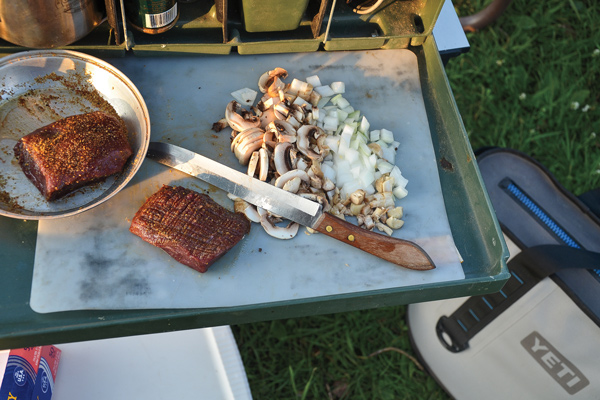
Print RecipeThere’s just something about camp meat that makes it special. The hard work it took to earn it and the surroundings certainly don’t hurt. As good as cooking venison is, there are ways to make it better. Fresh meat presents some challenges, especially considering it’s often carved from the bone well before it goes through rigor mortis, which causes even tender cuts to become tougher.
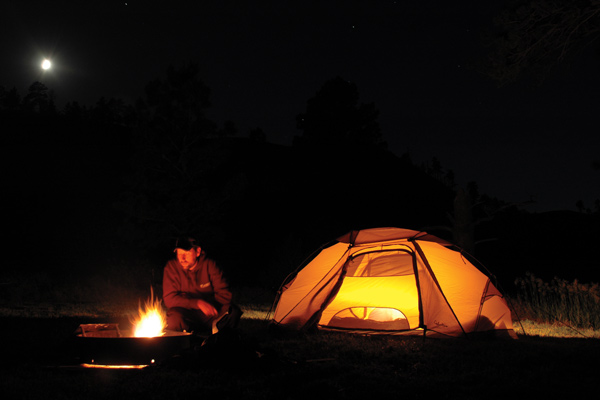
Here are some tips for getting the most from your animals, whether it’s a freshly killed elk grilled high in the Rockies, or a Northwoods whitetail hanging outside a traditional family deer camp.
Cooking Venison That’s Tender Or Tough?
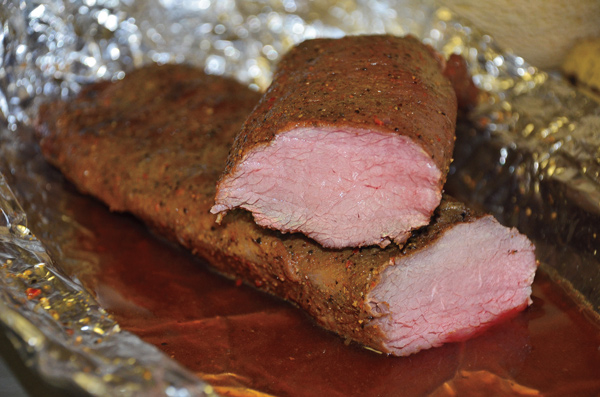
Every hunter knows which muscle is the softest on any ungulate — the tenderloin. Heck, it even has the word tender in its name. But did you ever wonder why the tenderloin is so tender? Because it doesn’t do any work. I’m sure there is a physiological reason it exists, but as far as I can tell, the tenderloin’s one job is to hang there inside the abdomen and grow delicious. It’s such a delicate cut that it requires no aging and should be eaten right away, before it dries out.
So what’s a hunter to do when it’s day three in camp and both tenderloins have long since been digested? Which cut comes next on the tenderness scale? Taking a lesson from the tenderloin, muscles that do the least amount of work are also the easiest to chew. Those that move often — think lower legs, shoulder and neck — are the toughest.
A good general rule is the farther a muscle is from an animal’s head or hooves, the softer it’s going to be. Go for the sirloin end of the backstrap, flank meat, and that hidden gem — the eye of round — which is the long, slim muscle attached to the bottom round. It’s easily identifiable as it looks a lot like a tenderloin, and although not as tender, is still the softest option of the muscles that make up an animal’s hindquarter.
Not So Offal
Back in the day, the first animal parts that got eaten were usually the organs, otherwise known as offal. Many a deer camp has served a big plate of liver and onions soon after the first buck was tagged, and fried slices of heart is a tradition held close to hunters’, well, hearts. But somewhere along the way, innards fell outside the mainstream idea of what was edible, and you’d be hard pressed to find a plastic bag reserved for the heart and liver among a backcountry hunter’s butchering kit.
Thankfully, attitudes toward offal are changing, and the pendulum is swinging back towards saving these tasty bits. But, like anything, you have to cook them right. Both the heart and liver fall on the tough side of the equation, and require specialized preparation and cooking techniques, particularly if you plan on eating them in camp.
The heart is an active muscle, so trimming is the first order of business. There are several tubes that come out of the top of the heart. These are the valves, veins and arteries, and they should all be trimmed away using a sharp knife. Same goes for the hard, white fat often found ringing the top of the heart. Some of this will melt away during the cooking process, so don’t feel like you need to remove it all.
Next, make a long, clean cut lengthwise in a line between the two largest holes, opening the heart up like a book. This will reveal more web-like connective tissues that can now be cut away and removed. From there, slice the heart in steaks or cube them for Peruvian anticuchos.
Cooler Aging
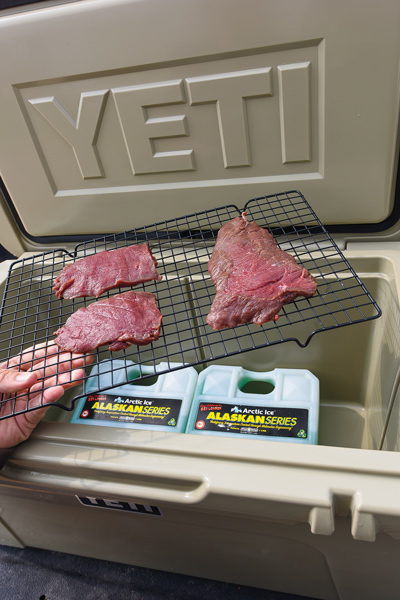
One of the tried-and-true ways to tenderize meat and make it more flavorful is aging, which uses naturally occurring enzymes that develop over time to break down connective collagens and fibers within the meat.
For cooking venison, the longer a cut of meat ages, the more tender it becomes. In a camp situation, it helps if you tag out the first day and can let the carcass hang for a week, but even a few days of aging can improve the taste and texture of a tough cut of meat.
The challenge of aging venison in a camp setting is providing a safe, consistent environment that will allow enzymes to develop without inviting bacteria, which thrives between the temperatures of 40 and 140 degrees. That means keeping the meat above freezing but below 40 degrees, or ideally in the 34 to 37-degree temperature range. The best way to do this in camp is with an extreme-duty cooler, such as those made by YETI.
To set up a cooler for aging, you’ll need some ice, preferably of the block variety, which melts much slower. Better yet are ice substitutes. I like those made by Arctic Ice. Like warm temperatures, water — where bacteria grow — is the enemy to aging.
To keep the venison dry, shop around to find a rack that fits inside your cooler. Those used to cool baked goods on the counter work great — anything to keep the venison up off the ice.
Place the rack on top of the ice, and then pat the meat dry with a paper towel and place it on the rack. Don’t stack or overlap meat, as you want all the surfaces exposed to the cool, dry air. At least once a day, preferably twice, open the cooler to let moist air escape, flip the meat, and dry the surface of it by blotting it with a paper towel. Repeat this process until your last night in camp, and then enjoy a delicious, and tender, steak dinner.
Field-Expedient Tenderizing
Even before a hunter dropped the first mastodon with a well-placed spear point, man has been dealing with tough cuts of meat. It didn’t take them long to figure out that beating steaks between two rocks was a great way to soften the long muscle strands that cause meat to be so tough. While there’s nothing wrong with using this same method, it’s a good idea to be a bit more civilized before cooking venison.
If you do want to channel your inner caveman, you should at least wrap the venison in between some plastic wrap, or barring that, a clean cloth.
Still, there is a better way, and it’s a close as your hip, assuming you carry a stout, fixed-blade knife. If you have a chuck box with you, a good camp knife works even better. Either way, you want one with a heavy spine, which can be used as an excellent stand-in for the blades of a mechanical tenderizer like those used to create cube steaks.
Simply flip the knife over in your hand, and then firmly pound the steak or chop with the knife’s spine. Turn the steak 90 degrees and repeat, creating a cross-hatch pattern, and then flip the meat and repeat the process on the other side.
Now cooking venison will feel like cooking beef.
Minced Meat
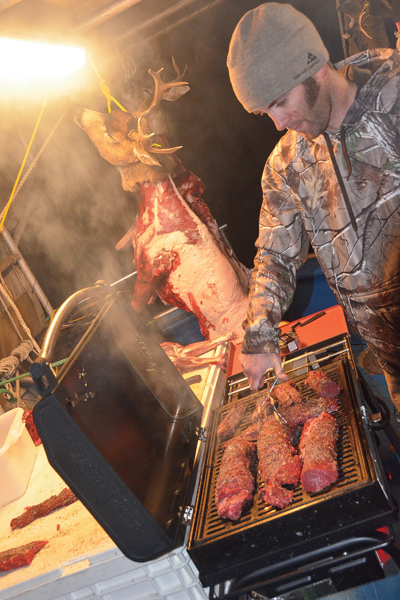
When I’m in elk camp, there are two things I start craving — pizza and hamburgers. While the former will have to wait until I get back to civilization, it is possible to make a reasonably good burger in the backcountry. And, like tenderizing, it requires a knife.
Mincing meat without a grinder is actually fairly easy, especially in small batches. Start by slicing a thin cut of meat into long, skinny strips. Once you have a stack of these, turn them perpendicular and cut the slices into the smallest cubes you can manage.
A sharp knife and cold meat make things easier. When you’re done, you should have a nice-sized pile of minced meat that looks like tartare.
Now, if you’re an adventurous eater, you could eat it just like this, as elk tartare is wonderful. But to get a burger, you’re going to need to add a little fat. Bacon grease is best if you have any on hand. (There is shelf-stable, precooked bacon available that is great for elk camp.) Or, barring that, pour in a little bit of cooking oil. As a last resort, water even works for cooking venison burger.
Cooking Venison Right
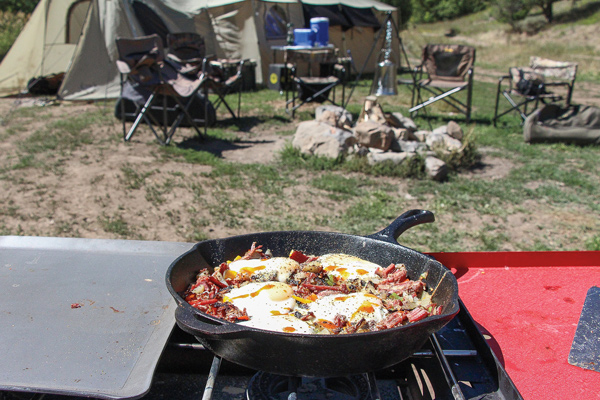
When it comes down to it, cooking the cut correctly is one of the most important factors in making it palatable. Whether it’s a tenderloin or shoulder steak, once it gets grilled past medium, it’s going to get tougher the more well done it’s cooked. So match the method to the meat, and keep cuts thin if you’re planning on grilling them over the fire or in a skillet. Thicker, tougher cuts require more time in a moist cooking environment that’s difficult to replicate in a camp without, at the very least, a Dutch oven.
One of the best camp meals I’ve ever eaten was also the simplest — a long, thin strip of caribou threaded onto a green willow and quickly roasted over a hot, smoky fire. Of course, that meal was flavored by an incredible view of Alaska’s Brooks Range, and it fed a hunger developed by packing quarters over two miles of muskeg, but it still sits up there with food I’ve been fed in the finest of restaurants. Treated with care, fresh camp meat can rank right up there with prime beef. You just have to treat it right.
